Human Mobility
Cash and Voucher Assistance (CVA) is frequently used to meet the needs of migrants in crisis. This page serves as a space to house materials connected to CVA and migration.

The Red Cross is preparing to provide humanitarian assistance to migrants ready to depart Honduras for Guatemala as part of a migrant caravan.
©Johannes Chinchilla / IFRC.
Conflict, economic crisis and natural disasters have forced people on arduous and risky journeys across multiple borders in search of safety, security and livelihoods. In 2020, the number of people forcibly displaced soared to a record high of over 80 million – nearly double the number a decade earlier. This trend is worsening and the effects of climate change threaten to displace up to 200 million people by 2050.
Increasingly, cash and voucher assistance (CVA) is being used to meet the needs of people on the move. It has been used at scale in various contexts from the 2015 European migration crises to ‘los caminantes’ from Venezuela. Equally, it has been used in other mixed migration crises, such as Central America, the Sahel, the Mediterranean, and the Horn of Africa. Currently, CVA is one of the main forms of assistance to the displaced populations in Ukraine and the surroundings countries.
There are many perspectives and definitions about what it means to be a migrant and how humanitarians should respond. Intentionally, we are not using a single definition for now as the discussion on CVA and migration is in its early stages a language is evolving.
Documenting and sharing evidence will help improve response effectiveness. This page houses a useful selection of resources related to migrants and the use of CVA. It will be updated as conversations evolve within humanitarian CVA spaces.
Current priorities
We aim to contribute to progress on this issue by:
- Supporting evidence generation at regional and global levels;
- contributing to practical solutions to delivering CVA to migrant populations; and
- convening evidence-based discussion on the key issues.
Featured content

Mapping a Route-Based Approach to CVA: Feasibility in select contexts in the Americas
Report
This research looks at the feasibility of a route-based approach to CVA in the Americas, presenting its potential through three perspectives: people on the move, humanitarian organizations, and financial service providers (FSP).
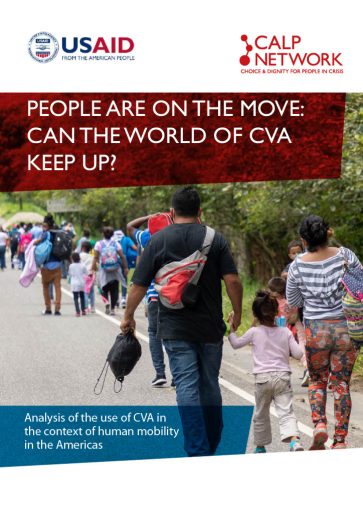
People are on the move: Can the world of CVA keep up? Analysis of the use of CVA in the context of human mobility in the Americas
Report
This study proposes a new vision for the implementation of cash and voucher assistance (CVA) in contexts of human mobility in the Americas region.

Four Reasons to Use a Route-Based Approach to Cash and Voucher Assistance
Blog Post
With human mobility being a fact of most humanitarian crises, is it time to change from a country to a route-based approach? With four key points, Holly Welcome Radice argues the time for a route-based approach has arrived.
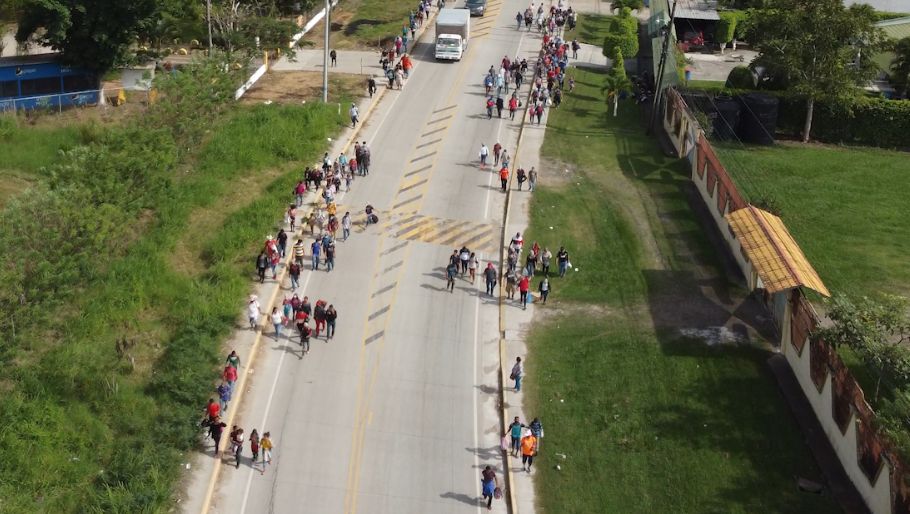
This is not a drill: Cash and human mobility
Blog Post
In this blog Paula Gil Baizan presents three new lenses through which we can view human mobility. She outlines how these lenses intersect with Cash and Voucher Assistance with a particular focus on the Americas.
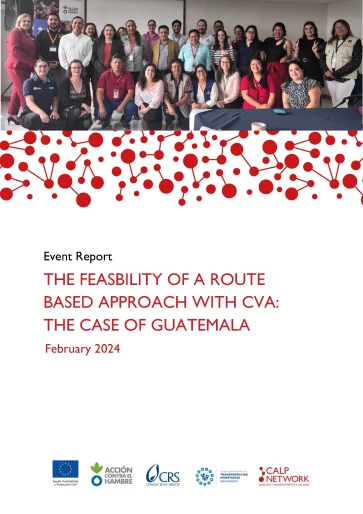
Event Report: The feasibility of a route-based approach with CVA: The case of Guatemala
Meeting minutes
In 2022, CALP recognized the importance of human mobility and CVA and invited its network to contribute to the evidence and debate. CALP conducted the study People are on the move: Can the world of CVA keep up? Analysis of the use of CVA in the context of human mobility in the Americas examined the use of CVA with people on the move. It also conducted several online exchanges on human mobility...

Onward Bound: Evaluating Cash and Voucher Assistance for Migrants on Sahel’s Migration Trail – Research and learnings from the Sahel region
Report
This research – a collaboration between the British Red Cross and Samuel Hall – provides evidence on the opportunities and challenges to integrate cash and vouchers assistance (CVA) as a support modality in migration programming in the context of transit migration in the Sahel. While CVA has become increasingly common and popular among implementing agencies and donors, there is limited...

DIGNIFYING, DIVERSE AND DESIRED: CASH AND VOUCHERS AS HUMANITARIAN ASSISTANCE FOR MIGRANTS
Report
This report looks at the use of Cash and Voucher Assistance (CVA) in supporting migrants. This report includes a baseline review of the use of CVA in the IFRC’s past and current operations assisting migrants, finding that in a 42-month period between 2018 and 2021, CVA was used in 25 per cent of the IFRC’s emergency responses assisting migrants. The report highlights over 35 diverse...
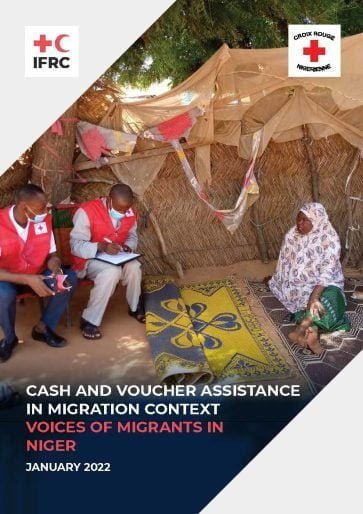
CVA in Migration Context – Voices of Migrants in Niger
Report
On 24–31 August 2021, the Niger Red Cross, supported by the IFRC, conducted a survey with 35 migrants in neighbourhoods around the capital city of Niamey to ask about their views on CVA, their preferences, and their views on digital identities. This report provides a summary of the responses from the migrant communities.
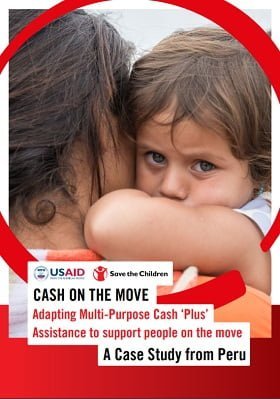
CASH ON THE MOVE – Adapting Multi-Purpose Cash ‘Plus’ Assistance to support people on the move in Peru
Report
In 2019 and 2020, with the support of USAID´s Bureau for Humanitarian Assistance (formerly FFP and OFDA), Save the Children implemented
a multi-purpose cash ‘Plus’ program in response to the influx of Venezuelan migrants into Peru.
Households that were only transiting through the cities where they were identified were provided with a one-off cash transfer assistance aiming
at covering...

Cash Transfers Programs and Human Mobility: Sharing experiences, debates, and learnings
Report
Cash Transfers have been one of the commitments of the Grand Bargain in which significant progress has been made. It should be noted that the challenges posed by different humanitarian contexts also oblige us to improve and revise these modalities of assistance in complex situations. The large flows of human mobility urgently require a design of solutions focused on transforming the system for...

IOM Cash-Based Interventions Annual Report and Case Studies 2020
Case Study
The IOM Cash-Based Interventions (CBI) Annual Report and Case Studies 2020 features case studies from a large number of missions that implemented CBI in 2020 and highlights the increasing use of cash and voucher assistance in IOM, reaching more than 1.6 million beneficiaries in 56 countries. The case studies give an overview of the broad range of CBI implemented by IOM and are divided into...

CVA in migration context – Voices of migrants in Kenya
Report
This report summarizes community consultations that were conducted in Kakuma refugee camp and Kalobeyei integrated settlement. It introduces the local context and the current user journey, experiences and preferences around cash and voucher assistance and digital identity solutions.
Thematic Leads
Latest
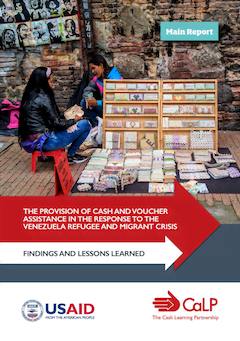
The Provision of Cash and Voucher Assistance in the Response to the Venezuela Refugee and Migrant Crisis: Findings and lessons learned – Main report
Report
This study, for which data was compiled between March and April 2020, seeks to document lessons and good practices in the delivery of CVA in Ecuador and Colombia by humanitarian organisations and governments, in response to migrants and refugees from Venezuela. The purpose of this analysis is...

Displaced & Disconnected – Connectivity for Refugees
Report
UNHCR recognizes that one of the ‘hard stops’ in facilitating mobile connectivity and access to finance for displaced populations is non-conducive regulatory environments. In particular, ID-related legal requirements have proven a significant barrier to access. For example, a refugee who cannot...
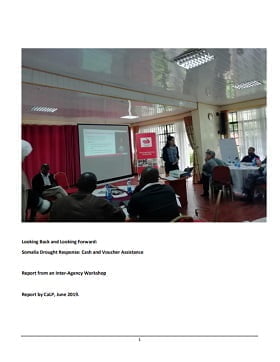
Looking Back and Looking Forward: Somalia Drought Response: Cash and Voucher Assistance
Case Study
This report summarizes the discussions that took place during a one-day learning event on 11th June 2019. The event brought together 27 people from national and international NGOs, the UN, and donors to discuss progress, reflect on cash and voucher (CVA) assistance in Somalia and identify priorities for...
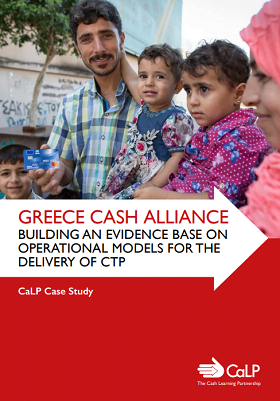
Greece Cash Alliance: Building an Evidence Base on Operational Models for the Delivery Of CTP
Report
The primary aim of this case study is to map out aspects of the Greece Cash Alliance (GCA) operational model influencing key drivers of quality (effectiveness, efficiency and accountability) in the delivery of multipurpose cash grants (MPGs). The GCA was launched in April 2017 with funding from ECHO, in...

Cost-Effectiveness in Humanitarian Work: Cash-Based Programming
Report
There is consensus in the literature that giving people cash in humanitarian contexts provides greater choice and dignity while at the same time stimulating local markets. In comparison to in-kind approaches, cash emerges as more efficient to deliver and – depending on the particularities of a given...
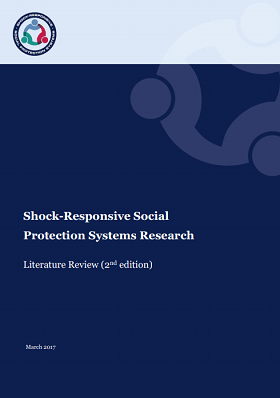
Shock-Responsive Social Protection Systems Research: Literature Review (2nd Edition)
Report
DFID has commissioned research into Shock-Responsive Social Protection systems, to further understand the nature of the interaction between social protection, humanitarian and disaster risk management systems and ways in which long-term social protection systems can be scaled up to provide support in...
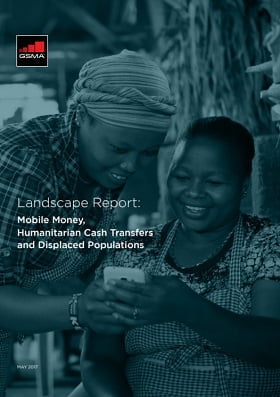
Landscape Report: Mobile Money, Humanitarian Cash Transfers and Displaced Populations
Report
Over the past decade, natural disasters and complex emergencies have led to a sharp increase in the need for humanitarian assistance. By the end of 2015, an estimated 65.3 million people were forcibly displaced globally, due to conflict and persecution. That same year, natural disasters caused the...

The Financial Journey of Refugees Full Report
Report
This document details how refugees and migrants from the Middle East, South and Central Asia and East, West and North Africa finance their journeys and manage money along the way.

Humanitarian Exchange: Special feature. New learning in cash transfer programming
Report
The special feature of this issue of Humanitarian Exchange, co-edited with Sarah Bailey and Breanna Ridsdel, focuses on new learning in cash transfer programming. While cash is now an accepted tool, and is increasingly being used in humanitarian response, most programmes are small and gaps in analysis and...

The Livestock Emergency Guidelines and Standards (LEGS)
Guidelines and Tools
A presentation giving insight to LEGS, discussing: Aims of LEGS Rationale of LEGS Development of LEGS Objectives and approaches PRIM LEGS training programme. Taken from the Cash Learning Partnership Global Learning Event Bangkok, 16-17 February 2011.

Cash-Based Safety Nets for Livelihood Support in Northeastern Somalia: A Feasibility Study for Save the Children UK and Horn Relief
Case Study
This study looks at the need for and feasibility of cash-based safety net programming within the operational areas of Save the Children UK and Horn Relief in Northeastern Somalia. The success of recent emergency cash transfer programs in Somalia permit the question of whether cash-based programs are...

Walking the Talk: Cash Transfers and Gender Dynamics
Case Study
Concern Worldwide (Concern) and Oxfam GB (Oxfam) jointly commissioned this report to look at the impacts of cash transfers (CTs) on gender dynamics both within households and communities. This report was commissioned because of the agencies’ concerns that while CTs, now being used in many different...
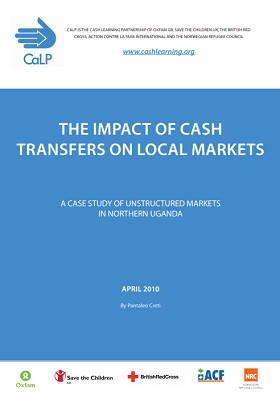
The Impact of Cash Transfers on Local Markets: A Case Study of Unstructured Markets in Northern Uganda
Case Study
This report explores the effects of cash transfers on local markets. It tests the hypothesis that ‘cash transfers to poor households lead to integration of markets in remote areas and strengthen existing well-integrated market systems’. To test the hypothesis, a case study was conducted in Northern...

Guidelines for cash interventions in Somalia
Guidelines and Tools
These guidelines are intended for all agencies operating in Somalia to represent a common approach to cash transfer programming for food security and livelihood activities in Somalia. The guidelines outline the minimum acceptable standards for cash interventions and provide the justification for...
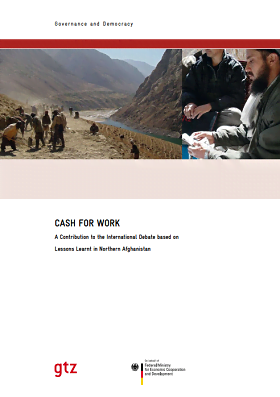
Cash For Work: A Contribution to the International Debate based on Lessons Learnt in Northern Afghanistan
Case Study
The purpose of this study was to document learning from BMZ finance cash for work (CFW) projects implemented by GTZ in Afghanistan as a contribution to international debates about cash transfer approaches. The operations of the GTZ CFW scheme in Northern Afghanistan are financed by the German Federal...
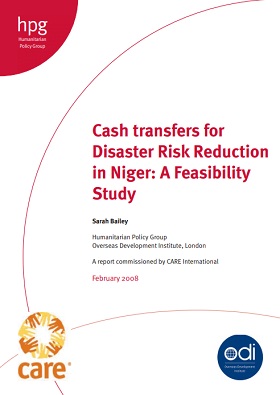
Cash Transfers for Disaster Risk Reduction in Niger: A Feasibility Study
Case Study
This HPG study report, commissioned by CARE, examines the appropriateness, cost-effectiveness and feasibility of cash transfer programming as part of a disaster risk reduction (DRR) strategy in Niger. It gives a general livelihood context of Niger and then looks at the feasibility and appropriateness,...
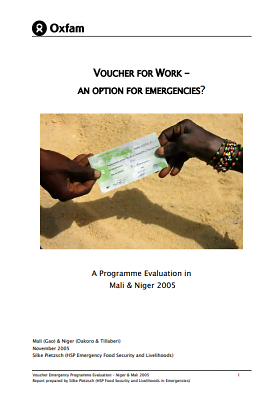
Voucher for work: An option for emergencies?
Report
This Oxfam GB evaluation report gathers successes, constraints and lessons learned during the implementation of two voucher programmes in Mali and Niger, following the food crisis in 2005. It begins by examining the appropriateness of the programme decision-making, and then looks at the two programme...
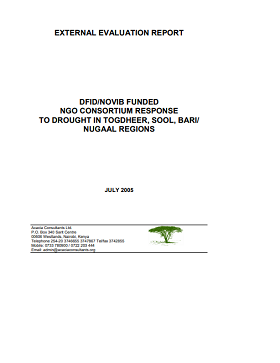
DFID/NOVIB Funded NGO Consortium Response to Drought in Togdheer, Sool, Bari/ Nugaal Regions
Case Study
This is a summary of the June 2005 evaluation of the NGO Consortium response to drought in Togdheeer, Sool, Sanaag and Bari/ Nugaal in Somaliland. The consortium response to drought was meant to provide cash to targeted drought-affected households to help them meet their basic needs. Important among the...



